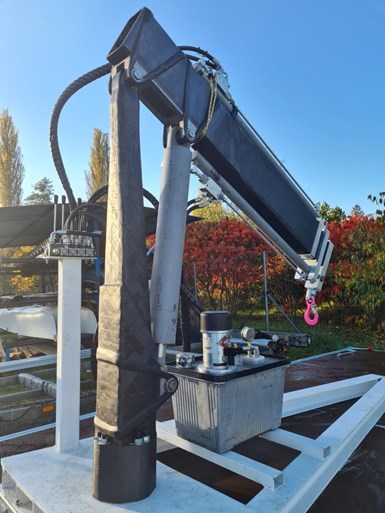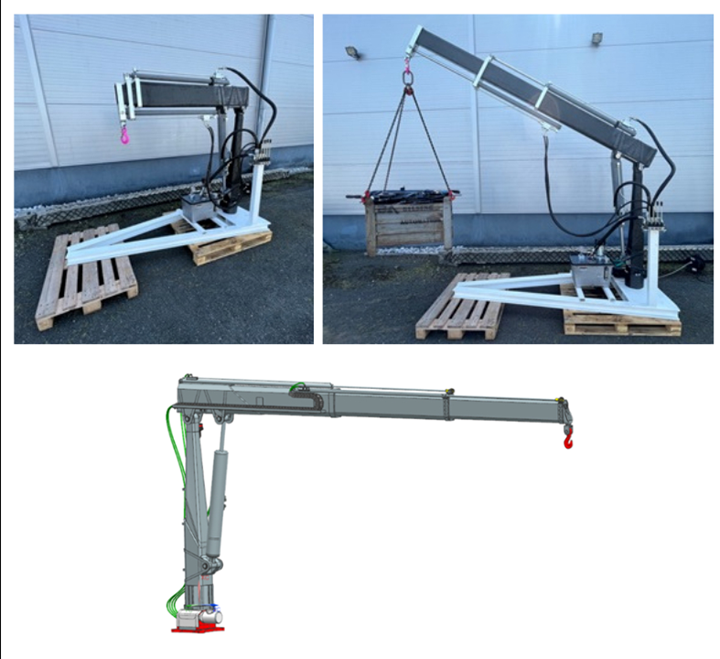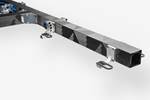CompoTech, RTI collaborate on composite mast, telescopic boom for mobile cranes, davits
Cost-competitive carbon fiber-reinforced epoxy crane design uses CompoTech’s automated composites processes, eliminating welding or heat treatment and producing 50-70% stiffer structures.

Side view shows the three interconnected boom sections of the fully assembled and operational “proof-of-concept” CompoTech/RTI carbon fiber composite telescopic crane. Photo Credit, all images: CompoTech
A lightweight carbon fiber crane mast and telescopic boom is being developed by a collaborative research and development (R&D) project team in the Czech Republic, which includes CompoTech (Sušice) and Regional Institute of Technology (RTI), the Faculty of Mechanical Engineering research center at the University of West Bohemia (Pilsen, Czech Republic). The project is based upon the use of an advanced automated composites process which uses robot-assisted filament placement to manufacture stiff, high-strength continuous fiber structures and integrated composite connections.
The new concept crane design is looking to offer a lighter and more cost-effective alternative to existing mobile hydraulic telescopic cranes and marine davits currently manufactured from steel, according to the partners. The project is part of the government-funded TRIO Program initiative, financed through the Czech Republic Ministry of Industry and Trade. The TRIO Program aims to drive greater innovation nationally in key enabling technologies such as photonics, micro/nano electronics nanotechnology, biotechnology, advanced materials and advanced manufacturing.
Dr. Ondřej Uher, R&D director for CompoTech, explains how the project work is divided between the two teams: “The CompoTech engineering team is responsible for project management, the design concept development and finalization, along with the production of all functional test samples and the epoxy carbon [fiber] composite mast and telescopic boom crane components. The RTI team is focused on creating the CAD models and kinematic analyses, setting the properties and performance in use specifications against crane standards and is carrying out the testing program of all the key design parameters and components, including dynamic fatigue testing of the final assembled proof-of-concept composite telescopic crane.”
The compact design is based on the dimensions and performance parameters of an existing mobile hydraulic steel telescopic crane. However, CompoTech notes, the component design and production method for manufacturing the carbon fiber-reinforced epoxy components for the mast and boom is very different. The composite mast has two interconnected components, a lower square base section and a tapered upper mast section. The telescopic boom is made up of three interconnected octagonal profile sections which fit into each other (see schematic CAD drawing, below).

The carbon fiber composite compact crane design is based on the dimensions and performance parameters of an existing mobile hydraulic steel telescopic crane, offering similar lifting capabilities with around 50% less weight.
The composite design uses CompTech’s proprietary automated axial carbon fiber placement technology to manufacture the crane’s hollow carbon fiber/epoxy mast and octagonal telescopic boom sections. The high-strength joints and fixture points on the mast and outermost boom section are manufactured using CompoTech’s continuous fiber integrated loop technology (ILT); according to the company, other projects have successfully used ILT to overcome joint design issues between sub-assembly components, enabling the production of much higher strength, fully integrated, joint holes for bolts which do not require drilling or overlaminating. The combination of these technologies are said to produce components with an E Modulus of 327 GPa, which is 69% stiffer than stainless steel (193 GPa) and 56% stiffer than tool steel (210 GPa), which are also a quarter of the mass.
The carbon fiber composite crane is expected be cost-competitive, as it can be produced using an automated process and eliminates the need for welding or heat treatment. Depending on the application, a composite coating system can be used instead of a multilayer paint system, which often needs reapplication over time. In addition to offering weight savings, the system will require less maintenance over its lifetime, as it will not be as susceptible to corrosion from the elements, especially salt water. The crane is expected to be particularly beneficial for mobile, telescopic cranes fitted on commercial and military vehicles, and for davits on smaller workboats and offshore platforms.
Performance results obtained from static and dynamic testing indicate that it should be possible to manufacture a compact composite telescopic crane using CompoTech’s carbon fiber placement and ILT technologies, a crane that will be able to provide similar lifting capabilities to an equivalent-sized steel crane, with around 50% less weight.
“The project has reached an important proof-of-concept stage,” Dr. Humphrey Carter, CompoTech’s head of business development, adds. “The results from the tests carried out by RTI are very encouraging, so much so that we believe that we have a design that could progress to commercialization. At this stage, we are interested to speak with potential crane manufacturers whom would like to become a collaborative partner for the next development stages of the project, to work with us to fully develop and field test the final product design and to evaluate the commercial opportunity and viability of manufacturing and supplying a lightweight carbon [fiber] composite crane to key target markets and applications.”
Related Content
Plant tour: Albany Engineered Composites, Rochester, N.H., U.S.
Efficient, high-quality, well-controlled composites manufacturing at volume is the mantra for this 3D weaving specialist.
Read MoreCombining multifunctional thermoplastic composites, additive manufacturing for next-gen airframe structures
The DOMMINIO project combines AFP with 3D printed gyroid cores, embedded SHM sensors and smart materials for induction-driven disassembly of parts at end of life.
Read MoreManufacturing the MFFD thermoplastic composite fuselage
Demonstrator’s upper, lower shells and assembly prove materials and new processes for lighter, cheaper and more sustainable high-rate future aircraft.
Read MoreJeep all-composite roof receivers achieve steel performance at low mass
Ultrashort carbon fiber/PPA replaces steel on rooftop brackets to hold Jeep soft tops, hardtops.
Read MoreRead Next
CompoTech launches standard range for carbon finer epoxy beams
Produced via AFP and precision press molded results in a high-strength carbon epoxy composite beam with 10-15% higher stiffness in the axial direction.
Read MoreAll-recycled, needle-punched nonwoven CFRP slashes carbon footprint of Formula 2 seat
Dallara and Tenowo collaborate to produce a race-ready Formula 2 seat using recycled carbon fiber, reducing CO2 emissions by 97.5% compared to virgin materials.
Read MoreDeveloping bonded composite repair for ships, offshore units
Bureau Veritas and industry partners issue guidelines and pave the way for certification via StrengthBond Offshore project.
Read More









.jpg;maxWidth=300;quality=90)













